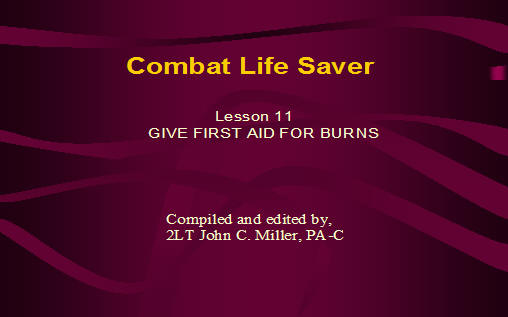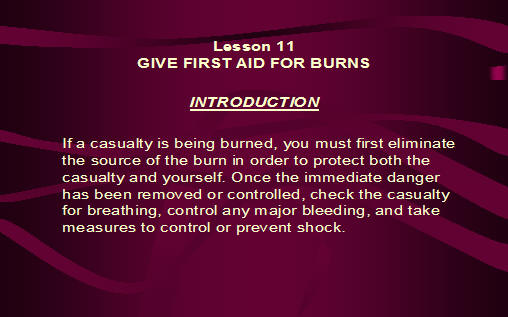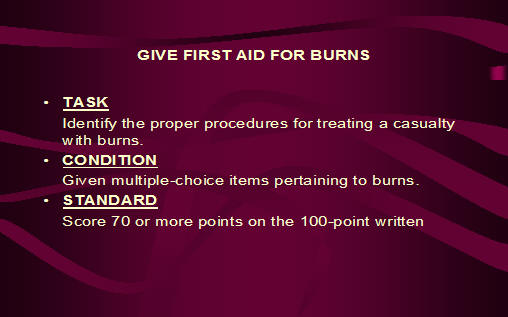Give First Aid for Burns
Click here to download the presentation.



Lesson 11
GIVE FIRST AID FOR BURNS
INTRODUCTION
If a casualty is being burned, you must first eliminate the source of the burn in order to protect both the casualty and yourself. Once the immediate danger has been removed or controlled, check the casualty for breathing, control any major bleeding, and take measures to control or prevent shock.
GIVE FIRST AID FOR BURNS
TASK
Identify the proper procedures for treating a casualty with burns.
CONDITION
Given multiple-choice items pertaining to burns.
STANDARD
Score 70 or more points on the 100-point written
CLASSIFY BURN AS TO TYPE
Burns can be classified by cause and by severity. Burns can result from thermal, electrical, chemical, or radiant sources. They are usually rated as being first, second, or third degree in severity.
Causes
Thermal burns are caused by heat. They can be caused by a flame, a hot object, steam, or the fireball from a nuclear explosion.
Electrical burns are caused by an electrical current passing through the body, such as from coming into contact with a “live” electrical wire.
CLASSIFY BURN AS TO TYPE
Chemical burns are caused by liquid or dry chemicals such as ammonia, caustic soda, quick-lime, or white phosphorus (WP).
Radiant energy burns can be caused by lasers, electric welding arcs, ultraviolet light, and microwaves. The primary danger is to the eyes.
Severity
First degree burns — The skin is red and painful like a sunburn, but blisters are not present.
Second degree burns — The skin is red and painful; blisters are present.
CLASSIFY BURN AS TO TYPE
Third degree burns — The skin layers are destroyed and underlying fat, muscles, and/or bone may also be damaged. The burn area may not be painful because the nerves have been destroyed, but the surrounding second and first degree burn areas may be painful.
PUT OUT FLAMES
If the casualty’s clothing is on fire, cover the casualty with a large piece of nonsynthetic material (such as a wool or cotton blanket) and roll the casualty on the ground until the flames are smothered.
If nonsynthetic material cannot be obtained quickly, get the casualty to the ground and have him roll on the flame until it goes out.
Do not use synthetic materials such as nylon and rayon because they may melt and cause additional injury.
REMOVE A CASUALTY FROM ELECTRICAL
CURRENT
If the casualty is lying on an electrical wire, assume the electrical wire is carrying electrical current and can be a danger to yourself as well as to the casualty.
Do not touch the electrical wire with your hands.
Do not touch the casualty since the current can pass from the wire and through the casualty to you.
REMOVE A CASUALTY FROM ELECTRICAL
CURRENT
Stop the Current
If the electrical current can be turned off quickly, such as flipping a switch, turn it off before removing the casualty from the wire.
Treat the wire as though it were still carrying current even if you think you turned off the current.
If it is quicker to separate the casualty from the wire, remove the casualty from the wire and administer aid first.
REMOVE A CASUALTY FROM ELECTRICAL
CURRENT
Separate Casualty and Wire
Two-rescuers: Slide a dry rope, dry clothing, or other material which will not readily conduct electricity under the casualty’s body and lift the casualty from the wire. Have a second person use a wooden limb or other long, nonconducting object to push the wire away from the casualty.
One rescuer: Wrap dry rope or similar material around the casualty limb or limbs and drag the casualty away from the wire.
REMOVE A CASUALTY FROM ELECTRICAL
CURRENT
Check for Breathing
Check the casualty’s respiration after you have separated him from the current. Administer mouth-to-mouth resuscitation if needed.
REMOVE CHEMICALS THAT CAUSE BURNS
Liquid Chemicals
Pour as much water as possible over the burned area.
If a sufficient amount of water is not available, use any nonflammable fluid to flush the area.
Dry Chemicals
Use a clean, dry cloth to brush off loose particles on the skin and flush the skin with as much water or nonflammable liquid as possible.
Do not flush dry chemicals unless water or other nonflammable fluid is available in large amounts. When combined with water, the chemical may change into an active, burning substance.
REMOVE CHEMICALS THAT CAUSE BURNS
White Phosphorus
White phosphorus burns when exposed to air. Quickly smother the flame with water; then cover the area with wet material or mud to prevent air from reaching the white phosphorus. Keep the material covering the phosphorus wet and occluded from air. Get medical help or evacuate the casualty.
Do not attempt to remove the white phosphorus particles from the casualty’s flesh.
Do not use grease or oil on the white phosphorus burn since they may cause the body to absorb the poisonous particles.
Do not use copper sulfate.
REMOVE CHEMICALS THAT CAUSE BURNS
Fallout
Brush off loose radioactive particles sticking to the casualty’s clothing and skin and flush the skin with as much water as possible.
Chemicals in the Eye
Flush the eye with water as quickly as possible.
Position the casualty’s head with the eye to be flushed lower than the other eye. This keeps chemicals from the eye being flushed from flowing into the other eye.
REMOVE CHEMICALS THAT CAUSE BURNS
Hold the casualty’s eyelid open.
Pour the water gently into the eye. Pour from the inner edge of the eye (end closest to the nose) to the outer edge.
Continue to flush the eye with water for at least 20 minutes.
TREAT RADIANT ENERGY (LASER) BURNS
OF THE EYE
Laser burns cause an immediate decrease in the ability to see.
Protect the casualty from additional exposure to the radiant energy source and keep the casualty out of bright sunlight.
The casualty’s eyes do not need to be bandaged, but he may feel more comfortable if a dark cloth or loose bandage is placed over his eyes if he does not need to walk or continue to perform his mission. If a bandage is applied, bandage only the involved eye.
Evacuate the casualty when the mission allows.
TREAT SKIN BURNS
At the time of the burn, apply copious amounts of water to the burn site.
Expose Burned Area(s)
Cut and gently lift away any clothing covering the burned area.
Do not pull clothing over the burned area.
Leave any piece of clothing that sticks to the burned area in place.
If you are in a chemical environment, do not expose the wound. Apply the dressing over the casualty’s clothing.
TREAT SKIN BURNS
Remove Jewelry
Remove any jewelry from the burned limb and put it in the casualty’s pocket. The jewelry which is not removed now may have to be cut off later if the limb swells sufficiently.
Dress and Bandage Burned Area(s)
Apply a field dressing over the burn wound and secure the dressing using the attached tails.
If the burn is an electrical burn, find and dress both the entry and the exit burn wound. The sole of the foot is a common location for the exit burn.
TREAT SKIN BURNS
If the burned area is large, use the cleanest material available to cover the burned area.
Do not try to clean the burned area before applying the dressing.
Do not apply any grease, ointments, or medications to the burned area.
Do not break any blisters that have formed.
Check for Shock
Fluid lost through burns is a cause of shock.
TREAT SKIN BURNS
Take appropriate measures to prevent shock or control shock.
If the casualty has second and third degree burns on 20 percent or more of his body, fluids should be administered intravenously.
If the casualty is not in shock and is not nauseated, give him small amounts of cool water to drink.
Get Medical Help
Seek medical help or evacuate the casualty, if practical.
Electrical burns can be far more serious than they first appear since most of the damage is done to the interior of the body.
GIVE FIRST AID FOR BURNS
CLOSING
A casualty with serious burns should receive intravenous fluids and be evacuated as soon as possible. If the burns to the skin are minor, the casualty should be evaluated by a medical person when possible since the burn is an open wound which can easily become infected if not treated.
This lesson is tested on the written examination.
Questions